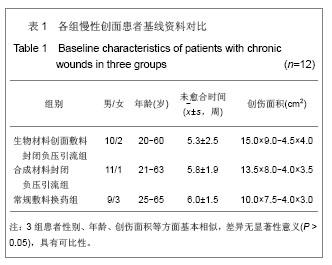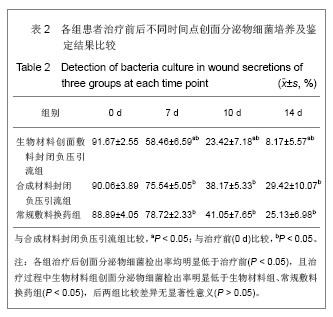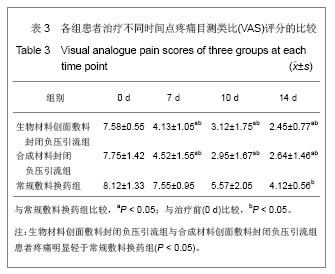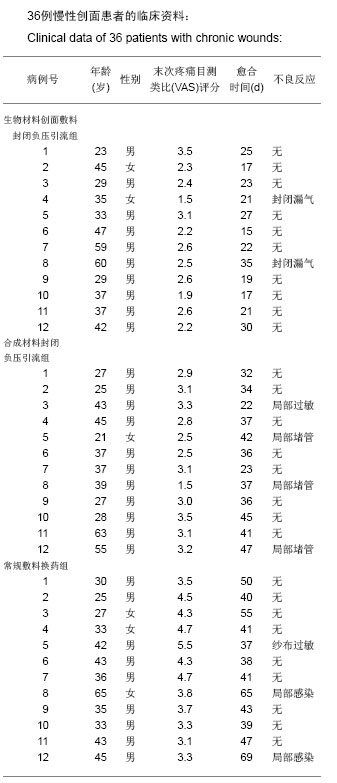| [1]Fu XB.Zhonghua Chuangshang Zazhi. 2004;20(8): 449-451.付小兵.进一步重视体表慢性难愈合创面发生机制与防治研究[J].中华创伤杂志,2004,20(8): 449-451.[2]State Council of the People’s Republic of China. Admininstratise Regulations on Medical Institution, 1994-09-01.中华人民共和国国务院. 医疗机构管理条例. 1994-09-01.[3]Ge XJ,Zhang HW,Shi JP,et al.Zhongguo Zuzhi Gongcheng Yanjiu.2012;16(3):539-542.葛小静,章宏伟,史京萍,等.藻酸盐银联合水凝胶敷料对慢性创面愈合的作用[J].中国组织工程研究,2012,16(3):539-542.[4]Li LY,Bai XD.Zhongguo Zuzhi Gongcheng Yanjiu yu Linchuang Kangfu. 2006;10(9):166-168.李凌云,白晓东.慢性皮肤溃疡的愈合与修复[J].中国组织工程研究与临床康复,2006,10(9):166-168.[5]Li XQ,Dan WH,Wang KJ,et al.Cailiao Daobao:Nami yu Xincailiao Zhuanji. 2009;23(1):374-377.李晓琴,但卫华,王康健,等.体表创面修复材料的研究进展[J].材料导报:纳米与新材料专辑,2009,23(1):374-377.[6]Hardin MO,Mace JE,Ritchie JD,et al. An experience in the management of the open abdomen in severely injured burn patients.J Burn Care Res.2012;33(4):491-496.[7]Benech A,Arcuri F,Poglio G,et al.Vacuum-assisted closure therapy in reconstructive surgery. Acta Otorhinolaryngol Ital.2012;32(3):192-197.[8]Gupta S. Optimal use of negative pressure wound therapy for skin grafts. Int Wound J.2012; 9 (Suppl 1):40-47.[9]De Brabandere K,Jacobs-Tulleneers-Thevissen D,Czapla J,et al. Negative-pressure wound therapy and laparoscopic omentoplasty for deep sternal wound infections after median sternotomy.Tex Heart Inst J. 2012;39(3):367-371.[10]Xu HD,Zhao JN,Lu JH,et al.Zhongguo Zuzhi Gongcheng Yanjiu. 2012;16(12):2189-2192.徐海栋,赵建宁,卢俊浩,等.基于生物材料创面敷料封闭负压引流在创伤性骨髓炎治疗中的应用[J].中国组织工程研究,2012, 16(12):2189-2192.[11]Fleischmann W,Streck W,Bombelli M,et al. Vacuum sealing as treatment of soft tissue damage in open fractures. Unfallchirurg.1993;96(9):488-492.[12]Penn E,Rayment S.Management of a dehisced abdominal wound with VAC therapy.Br J Nurs.2004;13(4):194-201.[13]Lindstedt S,Malmsjö M,Ingemansson R.Blood flow change in normal and ischemicmucardiam during topically applied negative pressure.Ann Thorac Surg.2007;84(2):528-573.[14]Malmsjö M,Ingemansson R,Lindstedt S,et al.Comparison of bacteria and fungus-binding mesh, foam and gauze as fillers in negative pressure wound therapy - pressure transduction, wound edge contraction, microvascular blood flow and fluid retention.Int Wound J.2012. [Epub ahead of print][15]Cigna E,Maruccia M,Sorvillo V,et al.The use of negative pressure therapy and hyaluronic acid for the management of post-traumatic lower limb injury.Int Wound J. 2012. [Epub ahead of print][16]Ito H,Arao M,Ishigaki H,et al.The use of negative pressure wound therapy to treat wound necrosis and groin lymphorrhea after inguinal lymph nodes dissection: a case report. Nihon Hinyokika Gakkai Zasshi.2012;103(1):22-26.[17]Danciu TE,Gagari E,Adam RM,et al.Mechanical stra in delive anti-aptotic and proliferative signals to gingival fibroblasts. Dent Res.2004;83(8):596-601.[18]Xu HD,Chen Y,Zhao JN,et al.Zhongguo Zuzhi Gongcheng Yanjiu. 2012;16(8):1505-1508.徐海栋,陈勇,赵建宁,等.基于生物材料创面敷料封闭负压引流在骨筋膜室综合症切开减压中的应用[J].中国组织工程研究, 2012, 16(8):1505-1508.[19]Xu HD,Zhao JN,Chen Y, et al.Zhongguo Zuzhi Gongcheng Yanjiu. 2012;16(12):2189-2192.徐海栋,赵建宁,陈勇,等.基于生物材料创面敷料封闭负压引流在创伤性骨髓炎治疗中的应用[J].中国组织工程研究,2012, 16(12): 2189-2192.[20]Xiong FM,Liu XY,Ge BF,et al.Zhongguo Jiaoxing Waike Zazhi. 2010;18(2):147-150.熊发明,刘兴炎,葛宝峰,等.封闭负压引流对早期处理爆炸创面的细菌和微循环的影响[J].中国矫形外科杂志,2010,18(2): 147-150.[21]Günter CI,Machens HG. New Strategies in Clinical Care of Skin Wound Healing. Eur Surg Res.2012;49(1):16-23.[22]Ansell DM,Holden KA,Hardman MJ.Animal models of wound repair: Are they cutting it?Exp Dermatol.2012;21(8): 581-585. [23]Senet P,Combemale P,Debure C,et al.Malignancy and Chronic Leg Ulcers: The Value of Systematic Wound Biopsies: A Prospective,Multicenter, Cross-sectional StudyMalignancy and Chronic Leg Ulcers.Arch Dermatol.2012;148(6):704-708.[24]Akita S,Yoshimoto H,Akino K,et al.Early experiences with stem cells in treating chronic wounds. Clin Plast Surg. 2012; 39(3):281-292.[25]Cutting K,White R,Mahoney P. Wound infection, dressings and pain, is there a relationship in the chronic wound?Int Wound J. 2012. [Epub ahead of print][26]He DP,Li SZ,Yin ZM,et al.Zhonghua Yiyuan Ganranxue Zazhi. 2006;16(2):177-179.何代平,李素芝,殷作明,等.高原和内地枪弹伤后细菌感染的对比研究[J].中华医院感染学杂志,2006,16(2):177-179.[27]Beno M,Martin J,Hatzl J.Vacuum sealing in the treatment and prevention of prosthetic infections--a case review. Rozhl Chir. 2010;89(8):508-512.[28]Labler L,Oehy K.Vacuum sealing of problem wounds.Swiss Surg.2002;8(6):266-272.[29]Liu L,Tan G,Luan F,et al. The use of external fixation combined with vacuum sealing drainage to treat open comminuted fractures of tibia in the Wenchuan earthquake.Int Orthop. 2012;36(7):1441-1447.[30]Tang J,Guo WC,Yu L,et al.Clinical efficacy of artificial skin combined with vacuum sealing drainage in treating large-area skin defects.Chin J Traumatol.2010;13(5):289-292.[31]Wolf SJ,Bebarta VS,Bonnett CJ,et al.Blast injuries.Lancet. 2009; 374:405-415.[32]Hofmann HS,Schemm R,Grosser C,et al. Vacuum-assisted closure of pleural empyema without classic open-window thoracostomy.Ann Thorac Surg.2012;93(5):1741-1742.[33]Siciliano RF,Waisberg DR,Samano MN,et al. Poststernotomy aspergillosis: successful treatment with voriconazole, surgical debridement andvacuum-assisted closure therapy. Clinics (Sao Paulo).2012;67(3):297-299.[34]Gudmundsdottir I,Steingrímsson S,Gudbjartsson T. Negative pressure wound therapy in Iceland – indication and outcome. Laeknabladid.2012;98(3):149-153.[35]Dowsett C,Davis L,Henderson V,et al.The economic benefits of negative pressure wound therapy in community-based wound care in the NHS. Int Wound J. 2012. [Epub ahead of print] [36]Matsushita Y,Fujiwara M,Nagata T,et al.Negative pressure therapy with irrigation for digits and hands: pressure measurement and clinical application.Hand Surg.2012;17(1): 71-75.[37]Dipaola CP,Saravanja DD,Boriani L,et al.Postoperative infection treatment score for the spine (PITSS): construction and validation of a predictive model to define need for single versus multiple irrigation and debridement for spinal surgical site infection. Spine J.2012;12(3):218-230.[38]Li TS,Choong MY,Wu HF,et al.Simplified negative-pressure wound therapy system for skin graft wounds.Plast Reconstr Surg.2012;129(2):399e-401e.[39]Lu XX,Chen SZ,Li XY,et al. Zhongguo Linchuang Kangfu. 2003;7(8):1244-1245.吕小星,陈绍宗,李学拥,等.封闭负压引流技术对创周组织水肿及血管通透性的影响[J].中国临床康复,2003,7(8):1244-1245.[40]Tan Q.Yixue Yanjiusheng Xuebao. 2011;24(2):113-116.谭谦.再生医学与组织工程[J].医学研究生学报,2011, 24(2): 113-116. |



